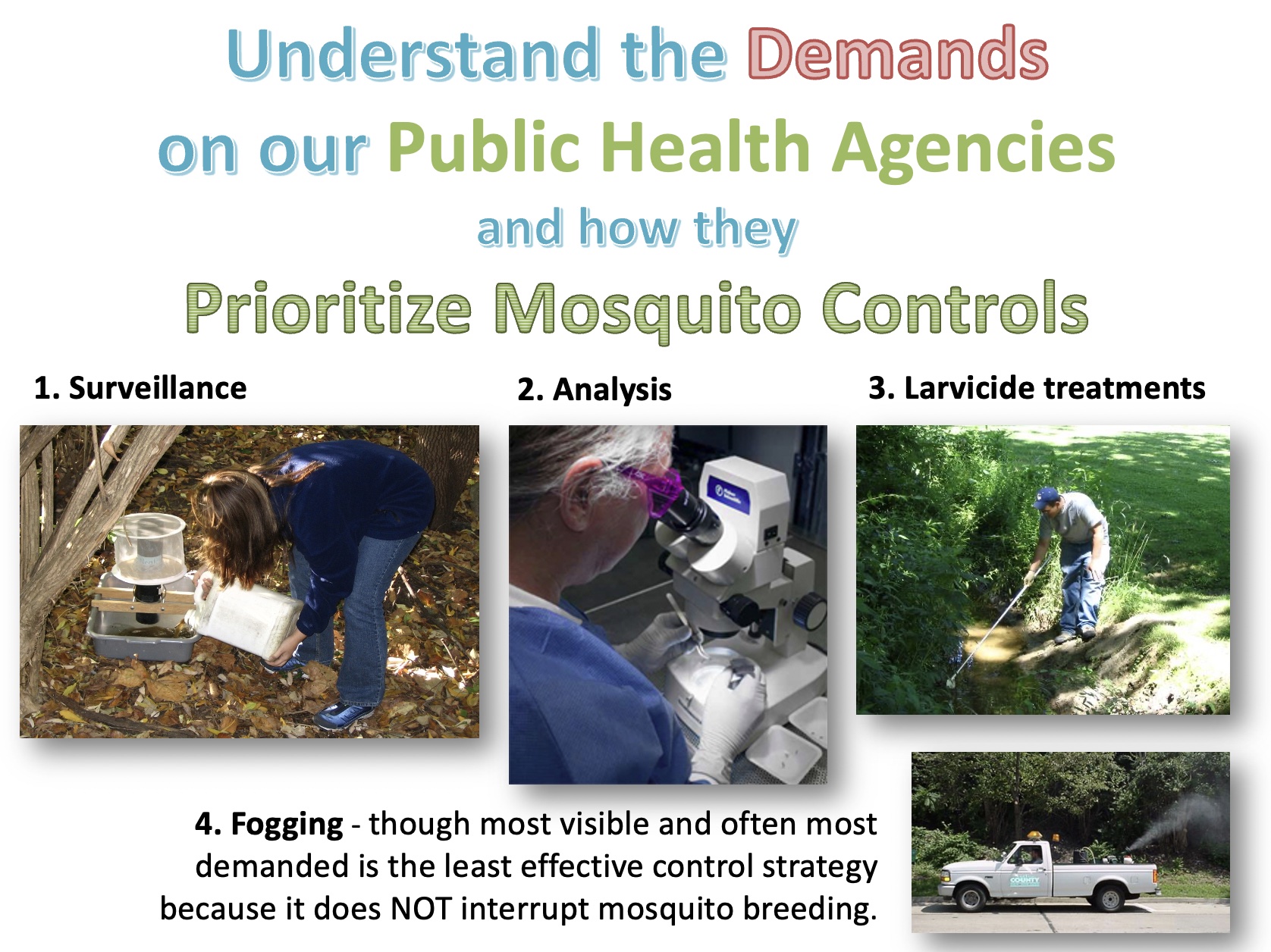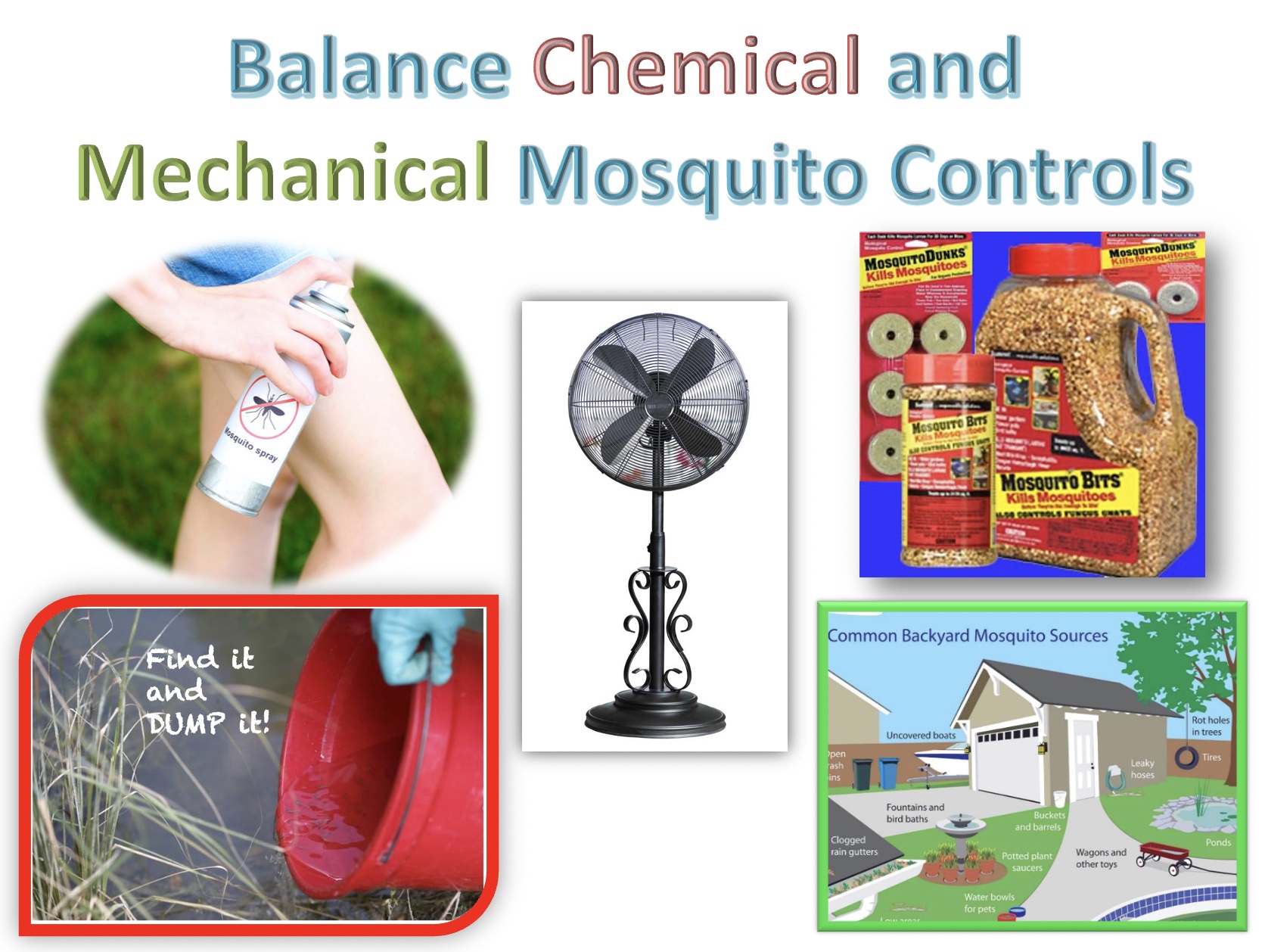By Jean Ponzi
Bug Spray Kills Bugs. Most people don’t realize this is the hard biological fact. Pest control ads touting use of “eco-products” perpetuate assumptions that aerial sprayed chemicals only target insect “pests.” As advocates for native plants and insects, we have the knowledge and the will to educate others about mosquito abatement methods that don’t harm the ecosystem we work to enhance. A personal focus on effective, strategic You-Can-Do is a powerful and healthy place to start.
Is there a niche for chemical control of mosquitos? Yes, but NOT the silver bullet Fogging Truck or hired Mosquito Guy. We need Eco-Logic to inform and direct our chemical powers, to protect the health of pollinators, people and plants. Our communities can save a lot of money too.
Priority One: Strategic personal shields
Spray stuff where you most want a barrier to biting mosquitoes: on yourself. Today’s range of repellants offer child-mild to super-strong protection. Do you know how personal repellants work?
Mosquitos are attracted by the CO2 we respire through our skin. Visualize this as a purple cloud, your personal CO2 aura. Every body’s chemistry is different. Some of us are palest mauve, barely visible to mosquitos. Others are day-glow violet, flagging hungry mamas in to nourish eggs with a blood meal. Mosquito repellant masks this aura of CO2. Key to success is testing and using the repellant that works for you.
The intense synthetic chemical mask from DEET was a military innovation to protect U.S. troops in mosquito-infested tropics. For years, DEET was the only repellant recommended by U.S. EPA, though cautions came with the thumbs-up. DEET may be your repellant of choice for a deep woods or jungle expedition, or if you’re an ultra-violet beam of CO2.
Milder chemical camouflage can come from active ingredients EPA now also recommends, including some directly obtained from plants. For example:
- Catnip Oil – a 2011 University of Iowa study found that Nepetalactone, a substance in Catnip (Nepeta cateria, in the super-scented mint family, Lamiaceae), is as or more effective a repellant than DEET. Imagine this plant’s aroma cloaking your CO2 – as it lures your cat.
- Oil of Lemon Eucalyptus – contains p-Menthane 3.8-diol (pmd, also a specific EPA approved active ingredient for repellants), another strongly aromatic plant essence, not recommended for small children.
- Oil of Citronella – the stuff we burn in candles is distilled from two grass varieties with the active ingredients citronellol, citronellal, and geraniol.
How to evaluate? Read up and try some. The Environmental Working Group provides a good summary of mosquito repellant options and concerns. Bonus: CO2 obscuration repels ticks too.
Two locally made plant-based repellants are Summer Spray from Cheryl’s Herbs in Maplewood and Citronella Mist made by Herbaria Soap on The Hill in south St. Louis. Both have a light minty scent that doesn’t linger, with no oily or cloying feel, and they don’t stain fabric. Both work for pale-plum me and I like using them even when dressed up. Spritz bottles of either one would be a healthy outdoor-party favor. With a DEET product also on hand, for your vividly amethyst friends.
Multiply repellant power with these simple measures for overall warm weather Eco-Sense:
- Go Fragrance-Free with personal-care products. Many scents attract mosquitos and other insects.
- Wear loose, light colored clothing. Space between fabric and your skin adds one more barrier element. Light colors are less attractive than darker hues, plus they reflect summer heat.
- Wear your loose togs long. Covered skin leaves less exposed to treat with repellant, logic that also prevents tick and chigger bites.
- Call in the winds to thwart mosquito landings. A lovely breeze from ceiling or portable fans will cool outdoor seating spaces and deter mosquito nip-and-sip.
Priority Two: Control mosquito breeding
All mosquito species need standing water to reproduce. Any current will disrupt their aquatic development stages. Our simple responsibility and charge: eliminate standing water, around our homes and neighborhoods.
After all is dumped – DUNK! For any stagnant water you can’t control, toss in some BTi. Mosquito Dunks or Mosquito Bits are dried, compressed BTi (Bacillus thuringiensis, subspecies israelensis), a bacterium found in soil. Spores of this biological larvicide release toxins into the developing guts of mosquito larvae. They stop eating and die. BTi will not harm birds, mammals, or other aquatic species. Insect toxicity is specific to the Diptera (fly) family, clan of Culicidae, the mosquitos.
Use mechanical action first, then – as necessary – fling out the safest chemical controls.
Priority Three: Talk to your neighbors and city leaders
Start from your fond, fun feelings about the pollinators winging to the native plants you grow. Talk from there about Eco-Logical ways to protect them, and ourselves. Positive, factual dialogue is a pest control strategy. Share this blog from Missouri Botanical Garden with your neighborhood group and municipal staff to start the conversation.
 Seed a “Tip & Toss Campaign” on your block, in your HOA, or in your community overall. Fertilize the effort with this thought: Responsibility means our Ability to Respond. Individual will and capacity to pitch in can evolve. Seeing neighbors take action is an action motivator. Make up some fun T&T yard signs!
Seed a “Tip & Toss Campaign” on your block, in your HOA, or in your community overall. Fertilize the effort with this thought: Responsibility means our Ability to Respond. Individual will and capacity to pitch in can evolve. Seeing neighbors take action is an action motivator. Make up some fun T&T yard signs!
Our public health departments know that chemical fogging does NOT interrupt mosquito breeding, but they must serve public needs – and the expectation that “we pay taxes” for official control of a pest. Understanding this constraint will breed empathy when you call on municipal staff to educate and ask about fogging cessation.
Now is the perfect time to begin, or continue, to spread the word in your community about how to cope with and control mosquitoes without endangering the health of people, pollinators and plants.
Jean Ponzi is Green Resources Manager at the EarthWays Center of Missouri Botanical Garden, a frequent speaker on eco-logical topics, and a proud member of Wild Ones St. Louis Chapter. Send your sustainable living questions to greenresources@mobot.org.



Wonderful information here! Thx so much!
Very wise approach for those of us who want to refrain from using chemicals!